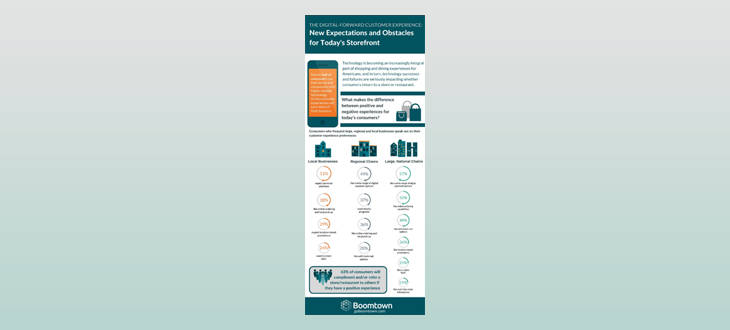
According to U.S. Census data, more than 90 percent of consumer spending happens in physical locations and not online. But brick and mortar retailers and restaurants face the challenge of increasing online sales. According to CB Insights, online sales growth is outpacing total retail sales 17 percent verses 6 percent year over year (Q4, 2017). And digital technology is influencing the offline sale. eMarketer cites Forrester Research which observes that “half of all retail sales in the US are digitally influenced, which is to say a consumer used a digital device before or during a shopping trip.”Leading this changing marketplace are a new generation of “digital-forward” brick and mortar stores and restaurants — from One Medical to Best Buy to Shake Shack to Starbucks. Primarily, national stores and fast casual restaurants like these are enhancing their on-premise customer experience efforts with the most advanced, intuitive and reliable technology.
Additionally, a number of digital-forward brands such as Amazon, Bonobos and Casper are now setting up physical storefronts to reimagine the in-store experience and capture additional customers. These leaders are shaping a new set of expectations and demands for today’s consumer. While this expectation is mostly being set by national brands, the digital-forward customer experience is raising the bar for retail and food service across the board — increasing pressure on regional and smaller, independent stores and restaurants to transform their own customer experience or risk being left behind.
Digital transformation of the customer experience also creates complexity — not just in developing a strategic plan and implementing new technology-enabled customer experiences, but in keeping this technology invisible to customers and tangibly offering better experiences than competitors. When restaurant and store managers struggle with many of the relatively simple systems they have deployed today, how will they cope with more complex, connected and interdependent solution sets? To understand the changing expectations, emerging opportunities, and obstacles in the restaurant and retail sectors, we surveyed over a thousand consumers across the U.S. The findings show that for many consumers, the digital-forward customer experience is now a critical part of a “good customer experience,” rivaling personal attention from staff and traditional loyalty programs that have always kept consumers coming back for more. We also found that consumers do consider these in-store experiences important and will take action, positive or negative, depending on how well or how poorly their expectations are met. And when the technology supporting these experiences performs inconsistently or even fails, businesses who are already facing the online onslaught are at further risk of eroding their customer base.
This infographic sums up the key findings of our research. We hope you enjoy and feel free to share!
.png)